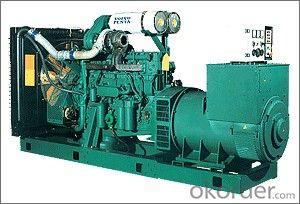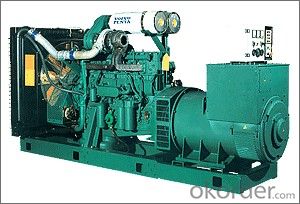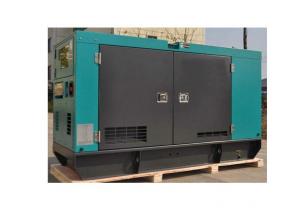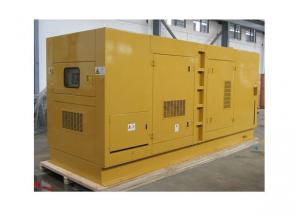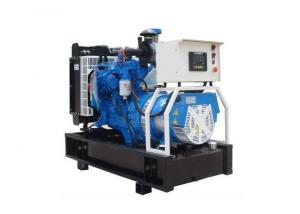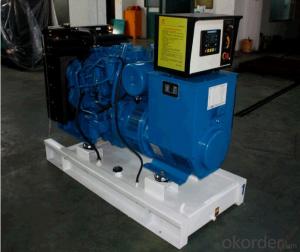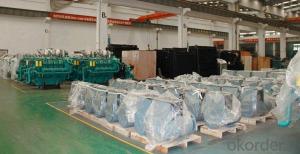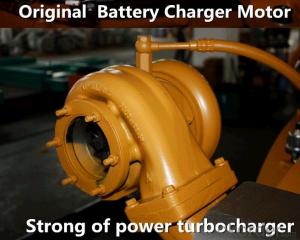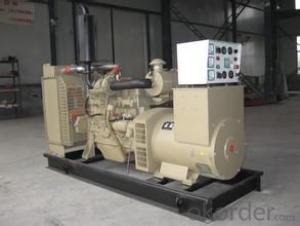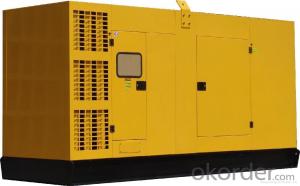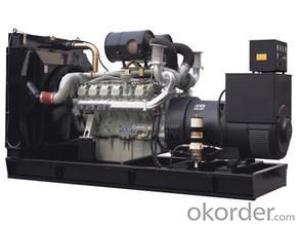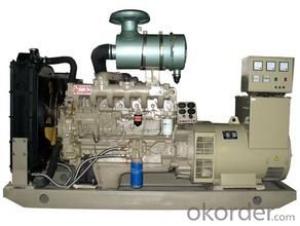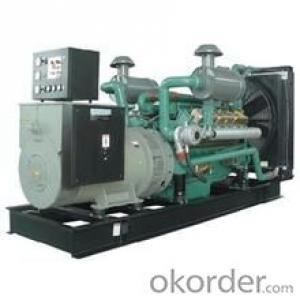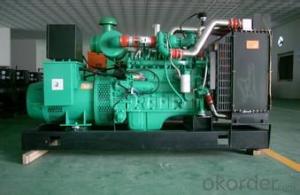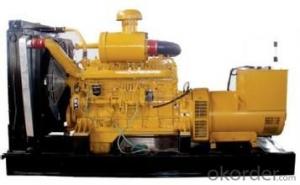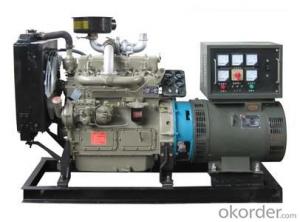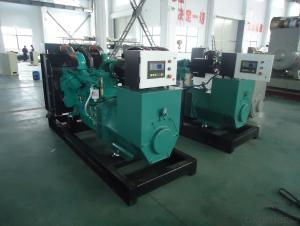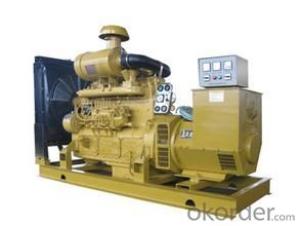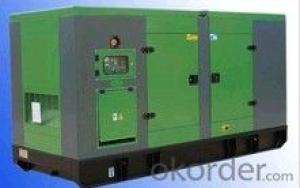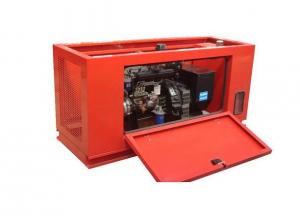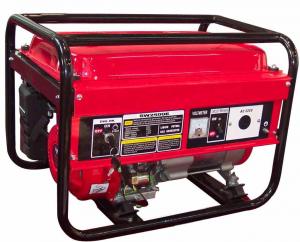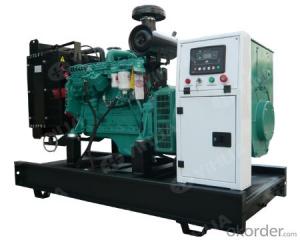Cummins Diesel Generator 500KW/625KVA C32
- Loading Port:
- Shanghai
- Payment Terms:
- TT OR LC
- Min Order Qty:
- 1 unit
- Supply Capability:
- 300 unit/month
OKorder Service Pledge
Quality Product, Order Online Tracking, Timely Delivery
OKorder Financial Service
Credit Rating, Credit Services, Credit Purchasing
You Might Also Like
| ENGINE DATA | |||||||
| Manufacturer: | Chongqing Cummins Engine | ||||||
| Model: | Original Cummins KTAA19-G6A, 4-cycle | ||||||
| Air Intake System: | Turbo, Water / Air Cooling | ||||||
| Fuel System: | Fuel Pump, EFC | ||||||
| Cylinder Arrangement: | 6 in line | ||||||
| Displacement: | 18.9L | ||||||
| Bore and Stroke: | 159X159(mm) | ||||||
| Compression Ratio: | 13:1 | ||||||
| Max. Standby Power at Rated RPM: | 610KW/830HP | ||||||
| Governor Type: | Electronic | ||||||
| Exhaust System | |||||||
| Exhaust Gas Flow: | 2054L/s | ||||||
| Exhaust Temperature: | 584℃ | ||||||
| Max Back Pressure: | 10kPa | ||||||
| Air Intake System | |||||||
| Max Intake Restriction: | 6.23kPa | ||||||
| Burning Capacity: | 750L/s | ||||||
| Fuel System | |||||||
| 100%(Prime Power) Load Consumption: | 206 g/Kw.h | ||||||
| 75%(Prime Power) Load Consumption: | 205 g/Kw.h | ||||||
| 50%(Prime Power) Load Consumption: | 206 g/Kw.h | ||||||
| Oil System | |||||||
| Total Oil Capacity: | 50L | ||||||
| Oil Pressure at Rated RPM: | 345-483kPa | ||||||
| Cooling System | |||||||
| Total Coolant Capacity: | 116.5L | ||||||
| Thermostat: | 82-93℃ | ||||||
| Max Water Temperature: | 104℃ | ||||||
| ALTERNATOR DATA | |||||||
| Manufacturer: | Original STAMFORD ,Marathon,MECC,Kaijieli | ||||||
| Frequency and Speed: | 50Hz/1500rpm | ||||||
| Altitude: | ≤1000m | ||||||
| Connecting Type: | 3 Phase and 4 Wires, “Y” Type Connecting | ||||||
| Power Factor: | 0.8 | ||||||
| Protection Grade: | IP23 | ||||||
| Exciter Type: | Brushless, Self-Exciting, with AVR | ||||||
| Insulation Class, Temperature Rise: | H/H | ||||||
| GENERATING SET DATA | |||||||
| Voltage Regulation, Stead State: | ≤±1% | ||||||
| Volts Warp(Sudden Reduce): | ≤+25% | ||||||
| Volts Warp(Sudden Increase): | ≤-20% | ||||||
| Frequency Regulation, Stead State: | ≤5% | ||||||
| Frequency Warp(Sudden Reduce): | ≤+12% | ||||||
| Frequency Warp(Sudden Increase): | ≤-10% | ||||||
| Frequency Recovery Time: | ≤5S | ||||||
| Open Type Size: | 3700(mm)X1570(mm)X2080(mm) | ||||||
| Open Type Weight: | 4820kg | ||||||
| Control System: | Original Uk deep sea auto controller | ||||||
| Standards: | ISO9001, ISO14001, European CE | ||||||
- Q: I'm a salesman for a welding supplies company, and a customer is interested in buying a diesel welder/generator for use in the paddock where he can't get electricity. While looking around I've come across a 200amp machine but it says it's a 200amp AC welder. it was my understanding that all welders are DC standard, and the AC current was only on welders to weld aluminum.
- DC is desirable, but not necessary for stick welding steels. DC produces deeper penetration in most cases. However AC can be used for stick welding just as well. AC is actually better when welding with E7024 rods. AC welders tend to be very robust because they're incredibly simple, basically just a x-former or alternator, a large rheostat, and an overload protector. DC systems are a bit more complicated. Fortunately, the machine in question seems to have 110V 15A outlets for residential-type power, in addition to the welding outlets, which are 75 volts on open circuit. Machines used for stick welding are of the constant current (CC) type. That means that the applied voltage will vary based on the resistance in the arc. Note that MIG welding uses Constant Voltage (CV.) (The current in MIG welding largely depends on the wire feed rate.) Residential current outlets also need to be constant voltage, not CC. How much welding experience do you have? A year or less? With due respect, perhaps you ought to be asking some of your customers for advice, not GIVING it to them.
- Q: I live in a remote location and my power bill is just ridiculously expensive -- I did the math and it seems like it'll be way cheaper for me to use my solar panel (which currently supplies DC power to a few parts of the house) and a diesel/oil/propane generator (which I have yet to purchase), and just cut off all mains power.Question is, which of these configurations is better?1)-Solar panel-DC generator-Large battery bank-High-wattage inverterResult: AC power throughout the house, using both solar panel and generator to charge the batteries as needed2)-Solar panel-AC generator-Smaller battery bank (for solar panel only)-No inverterResult: AC power when generator running, DC power from solar panel and batteries (I use DC right now for lights and a few basic appliances so I can live without AC power)Or should I do a combination of both, like using an inverter for the solar panel to always provide AC power?Thanks.
- Solar okorder
- Q: I built my own, verry successfull HHO gas generator and I want to inject the gas being produced, strait into my car engine but the flame keeps going back into my hose, i have going strait into the air intake carb, and blowing up my generator! I built a little flashback arrestor with gas piping filled with aquarium airstones and that obviously didn't work. Where can i buy a professional industrial flashback arrestor so I don't have to make my own?
- Sorry you can't!
- Q: I have to wonder. WHY don't we have a car right now in 2010 that gets 100+ mpg?Ok we have the Honda Insight and Toyota Prius that get 50MPG+ WELL why not DOUBLE or TRIPLE or QUADRUPLE the Batteries and get 100MPG??? Seriously WHY NOT PACK Enough Lithium Ion batteries in there to get 300MPG?? You mean to tell me that with all the technology we have today in 2010 that we can't come up with a Hybrid that gets 100MPG??? PURE NonsenseSomeone somewhere is keeping the 100MPG car from being produced. Simple as that. You mean to tell me that you can't pack enough Lithium Ion batteries into a CAR to get 100MPG??? Yea right. You know it could be done. BIG OIL and other political forces DON'T WANT the 100MPG car. Why did gas prices go to $4.50 per gallon??? TO get the $$$ While the Getting was good. Now the gig is up and they know it.
- Ok we have the Honda Insight and Toyota Prius that get 50MPG+ WELL why not DOUBLE or TRIPLE or QUADRUPLE the Batteries and get 100MPG?? Because the batteries aren't what gives the Prius it's high mpg. The Prius gets its high mpg because the engine is sized for steady state driving rather than acceleration. This allows the engine to run in the most efficient rpm range most of the time. The electrical components are there to provide the additional power needed for acceleration and to allow electric running for short periods during very low power demand when the engine would run outside of the efficient band. People have put in additional batteries in the Prius and mostly they received less mpg. Note that Plug-in cars don't improve mpg, they just transfer the cost of gas to the cost of electricity. This may or may not improve overall economy depending upon driving conditions, trip length, and electric rates. In 2011 there will be a smaller version of the Prius. This should be capable of 100 mpg as I've been able to get 70 mpg over a fill (about 600 miles) in the 2004 Prius on occasion, though between 60 and 69 is more common. FWIW, the Prius was developed in four years (1992 to 1996 when the 1997 model started shipping)
- Q: For anyone well up on EMD E and F units: saw a rather frightful picture last night of an F unit slamming into a switcher. not pretty ofcourse. it was on a curve so the F unit fell to her side to the outside of the curve. but not before breaking in half right behind the cab. the picture caption remarked that this was a common feature of the Es and Fs. By design? for safety? or design flaw? first time id seen this type of damage to an F, and certainly have never heard this comment of them. can someone clarify please? Couple days ago i was doing some reminiscing of railfanning way back in the day. i was fondly thinking of the great time i had with the crews. got to thinking about more of the details. all the stuff they had shown me. then something popped into my head. torpedoes! back then, scary lil devices to me! but rightlyfully so. so while im here in questions, are track torpedoes still used (when needed)? are they still around? havent seen one in quite along time since ive thought about it.thank you!
- I seem to recall a reference in Trains stating that these were designed to buckle right behind the cab in order to protect the crew in cases of head-on collisions. Apparently, the buckling was intended to absorb energy that otherwise might crush the cab. I can see how the buckling might appear to be a design flaw in the form of a weakness in the frame that allows the buckling. But my understanding is that it was an intentional design feature, kind of like how a fuse is the weakest link for the purpose of protecting the rest of the circuit.
- Q: I don't see why I couldn't use my car's engine as a power generator. I would only need maybe 1000 watts. The car is a 1990 Ford F350 diesel.
- The easiest would be to get a heavy duty low-speed alternator (like used in police cars and cabs that spend a lot of time idling). It could put out over 1000 watts of 12 volt DC. Then get an invertor (DC-to-AC converter) rated for 1000 watts 120VAC output. If you are not using the alternator to make AC it will still do a great job on keeping your battery charged.
- Q: Explain the operation,advantages and disadvantages of diesel power plant?
- I am not sure what you are really asking about the operation of a diesel generator. You start the engine and connect the electrical load to the generator buss. If you are connecting to a grid or existing power system then you need to match the frequency of the grid. As to advantages and disadvantages, you need to state what you want to compare it to and how large the generator or system is.
- Q: Hi. Wondering if someone could help me out with some info on how to change the output of a generator from 60hz to 50hz without a converter? Some advice would be appreciated. Thanks .
- A generator frequency cam be changed to 60Hz to 50Hz by changing its speed in rpm. One should remember that frequency ,f PN/120, Hence N120F/P, where N is revoultions per minute and P the number of poles.If you have a frequency meter, run the Diesel engine until the frequency registers only 50 Hz. the voltage registered may be lower than the desired terminal voltage. Here, you adjust the potentiometer trim until the desired voltage at 50Hz is attained. During operation of the unit, if the load is lesser than its rating, the voltage droop at the regulator has to be adjusted ,either increase or lower droop. If your generator is smaller than what I referred to, you will need a frquency meter and AC Voltmeter.
- Q: Example 1:A GP38-2 has a 2000 HP prime mover diesel engine.What are the horsepower ratings of the electric motors geared to the axle? [4 electric motors; 1 on each axle how much HP?]Example 2:An SD38-2 has a 2000 HP prime mover diesel engine.What are the horsepower ratings of the electric motors geared to the axle? [6 electric motors; 1 on each axle how much HP?]I know the tractive effort of the SD unit would be higher, but with 2 more motors on the axles, does it have more horsepower also?
- The short answer is, the horsepower is fixed. That is determined by the diesel engine and that can't make more power, it is just divided either by 4 or 6. A 3000 HP GP 40 locomotive pulls considerably more amperage than a 3000 HP SD 40, same horsepower divided by fewer axles, which is of course why the 6 axle pulls so much better at extended low speeds than 4 axles. The total horsepower stays the same, at full throttle the prime mover cant make anymore, your GP-38 will not be able to make any more power than an SD-38, both 2000. Added: At full throttle the main generator is putting out all the power it can, there can be no more load on it, that is fixed, the variable is the number of axles. Avio's figure of 750 HP per axle is absolutely correct, But those 750 HP motors in a 3000 HP locomotive obviously are never making over 500 HP each, there isnt enough power available from the main generator. That is why those motors last so much longer and are able to pull heavier loads, they are never making their maximum power. The amps we see on our meter in a locomotive dash is measured at the number 1 traction motor, not the generator/alternator output. At 10 MPH under maximum throttle a 3000 HP SD-40 (6 axles) pulls around 900 to 1000 amps (per axle), at the same speed a 3000 HP GP-40 (4 axles) locomotive is pulling well over 1200, heat buildup is a factor, short time ratings are soon exceeded and wheel slip is uncontrollable. Good question.
- Q: Here in Tamil Nadu in India, we are facing Neelum storm.
- Best wishes for a good outcome regarding your storm. I was lucky with outcome of Sandy. Power out for two hours only and no damage to Pennsylvania home. Still waiting on information regarding my family's shore home in New Jersey. Lucky that father left the island ahead of storm. No word yet, on condition of home on the water. No one can go back onto the island yet. We expect that our docks are gone and the garage is flooded based on pictures posted. Thankfully, the boat was already dry docked a few weeks ago. It should be okay. New Jersey apparently took the biggest hit from the storm.
Send your message to us
Cummins Diesel Generator 500KW/625KVA C32
- Loading Port:
- Shanghai
- Payment Terms:
- TT OR LC
- Min Order Qty:
- 1 unit
- Supply Capability:
- 300 unit/month
OKorder Service Pledge
Quality Product, Order Online Tracking, Timely Delivery
OKorder Financial Service
Credit Rating, Credit Services, Credit Purchasing
Similar products
Hot products
Hot Searches
Related keywords
